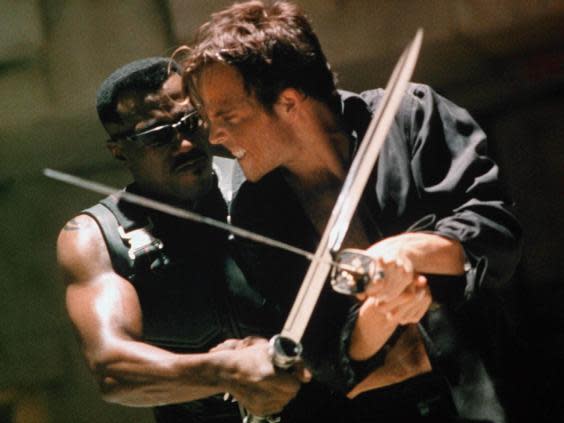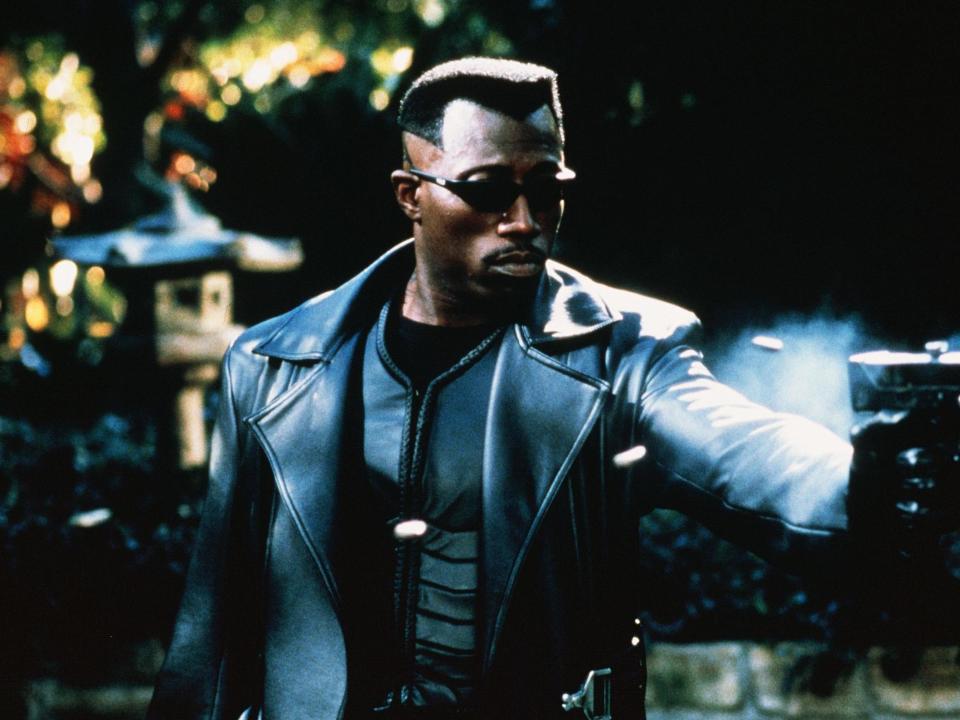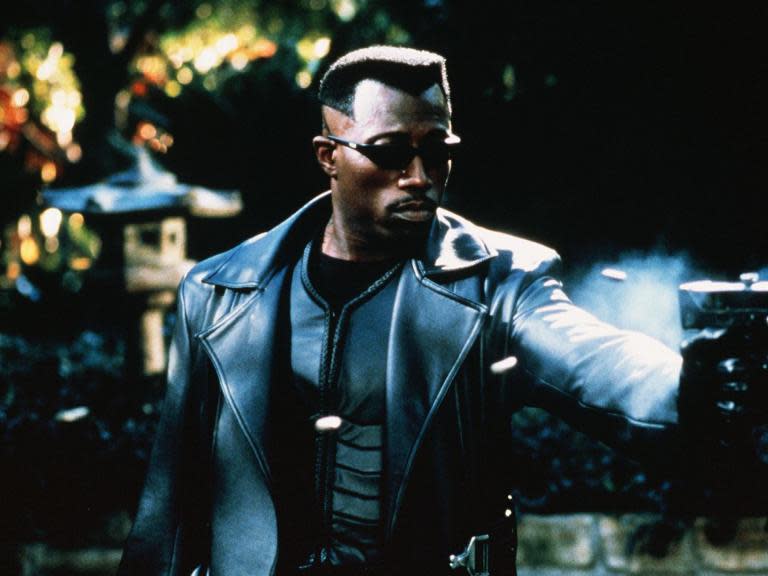How Blade created the Marvel Cinematic Universe
This year, the biggest event in cinema will be a CGI smackdown starring Josh Brolin as a huge purple head and one-time Oscar nominee Robert Downey Jr as an annoying billionaire bunged inside a flying tin suit. Yet step back 25 years and the truly extraordinary thing about Avengers: Endgame would not be its overheated storyline or glittering cast. It would be that a serious box office contender had anything to do with Marvel Comics.
The caped conglomerate is today in its imperial phase. The Marvel Cinematic Universe is the most potent brand in cinema, the $18bn jewel in Disney’s mouse-eared tiara. But until the late Nineties, Marvel was something very different: a cautionary tale in how not to engage with Hollywood. The film that changed all that was 1998’s Blade – an R-Rated slash ’em up featuring Wesley Snipes as cinema’s first African-American superhero, and with a trash-horror aesthetic owing more to Dario Argento and George A Romero than Superman or Batman.
Did Blade single-handedly save Marvel? It may sound hyperbolic. Yet a case can certainly be made that it did. Marvel was by the mid-Nineties a disaster waiting to burn down to the ground. With flops such as 1986’s Howard the Duck and a Fantastic Four movie so bad that it didn’t make it to video, it shivered in the margins as the scrawny, Pre-Captain America Steve Rogers of comic-book franchises.
The death knell rang in earnest when the comic-book collectors market collapsed and retail sales fell 70 per cent in just a few months. Sandman author Neil Gaiman had warned a few years earlier that comics were caught up in a high end collecting bubble that would burst. The industry failed to pay heed and Marvel bore the brunt of the downturn.

The inevitable duly came to pass in 1996 as the company, having tried to arrest the decline by hiking its prices, filed for bankruptcy. Yet just two years later it would swing back with a vengeance, with the first great superhero movie of the modern era. And also the first Marvel adaptation not to be a smoking disaster. Every subsequent triumph, from X-Men and Spider-Man to Iron Man and Avengers: Infinity War, flows from what Blade accomplished.
Blade was, of course, remarkable in its own right and a deserved smash. This story of a “Daywalker”, half man-half vampire waging a one-person war against a secret army of blood-drinkers, struck up a deliciously bonkers tone from its opening scene in a nightclub, where the water-sprinklers sprayed blood on the dancers. The action is relentless, the vampire special effects winningly creepy and the charismatic Snipes a force of nature as a tortured soul in mirrorshades, who lives only to kill vampires.
Watch the film today and what is especially striking, though, is how lustily Blade resists the convention that would come to define the MCU. Snipes’s anti-heroic Blade is in no hurry to be likeable. What humour there is leans towards gross-out – such as when Blade slices a group of vampires with a bespoke killer boomerang before they’ve quite processed what’s happened. There is a banging techno soundtrack. And it is gloriously violent. Vampires are split down the middle and cut off at the midriff with maximum squelchiness.
Most revolutionary of all, however, was Snipes as the face of a blockbusting franchise. True, the then 36-year-old actor was one of the biggest action stars in the world, with Demolition Man, Rising Sun and Passenger 57 under his belt. Yet that hadn’t prevented at least one executive wondering aloud to Blade screenwriter, David Goyer, whether the character’s colour might not be changed to white. A black superhero, it was suggested, was not something the industry could get its head around.
The film's significance in terms of African-American representation wasn’t much commented upon at the time. And its importance was glossed over entirely as critics tripped over one another rushing to praise 'Black Panther' last year
Even if you set aside the question of race, it was unclear whether Snipe’s wattage would compensate for the obscurity of the Blade character. The vampire slayer had first popped up in 1973 in a little-known Marvel series, The Tomb of Dracula, partly inspired by American-footballer-turned-actor Jim Brown. Appropriately, given his vampiric background, the character would go on to have a strange twilight existence. Many hardcore Marvel fans loved Blade. But in name-recognition among the public, he was rungs below Superman and Batman.
Yet so was Iron Man when Robert Downey Jr strapped on his metal gauntlets for the first time in 2008. Indeed, the blueprint established by Blade – take an obscure Marvel character and treat them as if they’re as important as Batman or the Hulk – would soon become the foundational text of the Marvel playbook.
Blade’s significance in terms of African-American representation wasn’t much commented upon at the time. And its importance was glossed over entirely as critics tripped over one another rushing to praise Black Panther last year.
The paradox is surely not lost on Snipes, who is today trying to put his career back on track after serving a prison sentence for tax offences from 2010 to 2013. For him, Blade was the culmination of nearly a decade of struggle to bring a black superhero to the screen. He had initially tried to convince studios to back a Black Panther adaptation. But he had run aground both on Hollywood’s ignorance of comic books and also because of the background radiation of racism.
“I think Black Panther spoke to me because he was noble, and he was the antithesis of the stereotypes presented and portrayed about Africans, African history and the great kingdoms of Africa,” Snipes told The Hollywood Reporter last year. “It had cultural significance, social significance. It was something that the black community and the white community hadn’t seen before.”
With the blessing of Marvel father figure Stan Lee (onboard provided he received a cameo), Snipes pitched Black Panther to the studios. He quickly ran into issues. The first was that in the mid-Nineties, “Black Panther” was synonymous with Huey Newton’s militant black rights organisation. Few of the suits with whom he pressed the flesh were aware of an entirely unrelated African superhero.
The other problem was that even those on board with an adaptation of the Marvel comics struggled with Black Panther’s premise of a technologically advanced African society hidden in our midst. A disastrous meeting with Boyz n the Hood director John Singleton was typical of the response Snipes received.

“John was like, ‘Nah! Hah! Hah! See, he’s got the spirit of the Black Panther, but he is trying to get his son to join the [civil rights activist] organisation,’” he later recollected. “‘And he and his son have a problem, and they have some strife because he is trying to be politically correct and his son wants to be a knucklehead.’ … Ultimately, John wanted to take the character and put him in the civil rights movement. And I’m like, ‘Dude! Where’s the toys?! They are highly technically advanced, and it will be fantastic to see Africa in this light opposed to how Africa is typically portrayed.’”
Faced with shrugged shoulders on all sides, Snipes’s Wakanda project vanished into a development black hole. Still, there was light at the end of the void. Marvel, finally back from bankruptcy, was rethinking its movie and TV strategies.
Blade had been a long-term priority. As early as 1992 Marvel was looking to develop a film, starring rapper LL Cool J. But now the resurrected Marvel had a gung-ho new chief creative officer in Avi Arad. An Israel Defence Forces commando turned hard-charging executive, he made it his priority to change Marvel’s disastrous record at the box office.
New Line Cinema was on board, meaning it rather than Marvel, would take the bulk of the financial risks (as well as reaping any profits). And Arad had hired wunderkind screenwriter David Goyer, who had earned praise within the industry for his work on the Van Damme movie Death Warrant.
Goyer wasn’t just a top-notch writer with a bright future. He was also well connected. Which is how David Fincher, the hottest director in Hollywood on the back of Seven, came to read an early Blade script and put himself forward to direct.
“I knew David Fincher from way before, we were friends,” Goyer would tell Entertainment Weekly. “He was finishing Seven at the time at New Line and he read the script and was like, ‘What’s going on with Blade? This is pretty good, I just have some different ideas about it.’”
“So I said, ‘David, look, I would love to have you direct this movie. You’re my favourite director. But I know that you’re not gonna do it.’ We were going into a meeting with [New Line ceo] Mike De Luca and he couldn’t help himself. He started talking about the first act and what he wanted to do and I could see everybody just completely mesmerised and I knew right then we were gonna waste a year, which was basically exactly what happened.”
Goyer pitched the movie as a “Star Wars trilogy of black vampire films”. New Line was supportive of his vision. And they were fully onboard with Blade having an African-American star. The issue was how much they would have to cough up for the budget.
“Mike DeLuca said ‘I’ll make it for $40m if you can get Denzel Washington, 35 if you can get Wesley Snipes, and 20 if you can get Laurence Fishburne,’” Goyer told EW. “And that was it. We wanted Wesley.”
Snipes said yes on the spot. He was on board as both star and co-producer, via his Amen Ra production company. Soon afterwards, Kris Kristofferson agreed to play his mentor, Whistler. The next headache to be solved was finding the right director. As Goyer predicted, Fincher had opted to do The Game with Michael Douglas instead. Nobody else in Hollywood seemed terribly interested.
Goyer then had a light bulb moment. He’d enjoyed a low-budget sci-fi horror by the first time UK director Stephen Norrington, who had cut his teeth as a special effects artist on James Cameron’s Aliens. Death Machine had been a bit of a mess – but the action scenes were relentless and had been put together on a shoe-string. Norrington, it turned out, was gung-ho about comic books. And when he and Snipes met there was instant chemistry.
But perhaps the biggest coup was casting spiky-haired heartthrob Stephen Dorff. He glittered menacingly as vampire villain Deacon Frost, who wants to break the centuries old covenant by which vampires keep a low profile and forbear from drinking the blood of every last human on the planet.
Dorff is today perhaps best known for his grizzled turn in the recent third season of True Detective. But in the late Nineties, he was one of Hollywood’s pre-eminent bad-boys. With the dangerous good looks of his drinking buddy Leonardo DiCaprio and the outlaw simmer of a young Johnny Depp, he was seen as a potential superstar. And Blade had him when he was hotter than hot. It was a turn of luck after the original choice for Frost, martial arts actor Jet Li opted to make his English language debut in Lethal Weapon IV instead.
He signed on – but with misgivings. Dorff had made his name in low-budget indie movies such as the Stuart Sutcliffe Beatles biopic Backbeat. Blade was something else entirely. This being the Nineties, he was worried he was selling out. Plus, he had justifiable ground to worry a film about a superhero who fights vampires might impact negatively on his standing in the industry. It was not unthinkable that it would be a disaster.
“I thought Blade would be the end of my career,” he later said. “I didn’t think it was going to fly. I didn’t get it really, when I was making it. The actor is sometimes wrong – I might have been wrong on Blade.”
“It was interesting because back then Stephen [Dorff] was making movies with like, Jack Nicholson and Harvey Keitel,” his co-star, Donal Logue, would observe speaking to EW. “And at the time I think Leonardo [DiCaprio] and he were the young hot talents of Hollywood. I’m just a character actor, and I’ve been happy in that regard, but I didn’t realise the pressure of being a big leading man and all these decisions you have to make in terms of career trajectory. And I could feel that with Stephen – he had to be careful.”
Blade was a hit but not an altogether smooth production. Dorff was on edge throughout and Norrington not always appreciative of Snipes’s ad-libs. Goyer, meanwhile, had to scramble to fix the film after a disastrous test screening.
The original denouement saw Frost transform into a huge globulous hurricane of blood and fight Blade. But the CGI was atrocious and it was clearly wrongheaded to shuffle the charismatic Dorff off-screen prematurely. So a new ending was shot in which Blade and Frost clashed in a climactic sword fight. This put the release date back a year. Had the Marvel curse struck again?
Others thought that black people or black talent in film doesn’t sell internationally, doesn’t sell foreign, doesn’t sell in Japan. 'Blade' comes out, and it blows up in Japan, despite the fact that the lead is a black guy
Far from it. Blade did reasonably well with critics – and this at a time when comic movies were routinely met with hostility. The Washington Post praised “its bone-crunching martial arts and cynical humour” and Roger Ebert, in the Chicago Sun Times, praised the “pure visceral imagery”. Alas, The Independent was not so approving, lamenting that “noise and martial-arts action” masked “its tinny pedigree”.
Nonetheless, it became a huge hit, earning $131m worldwide and many times more on DVD. Thus it defied Hollywood predictions that a film with a black lead would struggle in America and flop completely overseas.
“I remember, one of the executives of the studio at the time, in the screening, commented after they did the focus group, and they got back the numbers, and they saw how the numbers were so high, and there was so much appeal for the character and the world, he commented, ‘I don’t understand why people like this,’” Snipes would say.
“There were others who thought that black people or black talent in film doesn’t sell internationally, doesn’t sell foreign, doesn’t sell in Japan. Blade comes out, and it blows up in Japan, despite the fact that the lead is a black guy.”
There was an unhappy coda with Snipes and Goyer falling out on the set of Blade: Trinity in 2004. That was amid increasingly eccentric behaviour by Snipes, who refused to leave his trailer except for close-up shots, leaving a body double to appear in all his other scenes. At one point he even attempted to strangle Goyer (who, over Snipes’s protests, had replaced the original director at the last moment). Their careers would subsequently go in the opposite direction. Snipes went to jail for tax fraud. Goyer later wrote Batman Begins and Batman v Superman: Dawn of Justice (nobody is perfect).
Norrington would for his part become his own cautionary tale with 2001’s The League of Extraordinary Gentlemen. The Alan Moore adaptation was a huge flop. And, after onset clashes with his star Sean Connery, Norrington vowed never to direct again. He has proved true to his word.
None of which diminishes the stature of Blade, either as a gory entertainment in its own right or for paving the way for the comic book onslaught to follow. It proved that Marvel properties could be successful – and that superheroes didn’t have to be Batman-level famous to chime with cinemagoers.
Marvel, it is true, earned just $250,000 from Blade because of its arrangement with New Line. But Avid Arad had made his point: there was an audience for Marvel films, provided they were well made and took the subject matter seriously. Soon afterward Marvel struck deals that would see big screen adaptations of Spider-Man (with Sony) and X-Men (with Fox). The Marvel uprising had begun.
“Everybody but us was shocked at the box office, and subsequently the DVD,” Arad would tell Digital Spy. “That was the beginning of the DVD revolution, and Blade was just like wildfire. After that, people were listening very carefully. Very carefully.”



